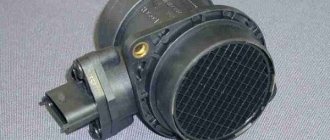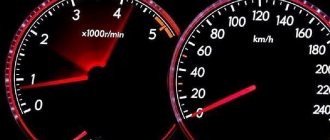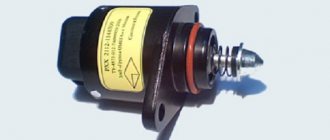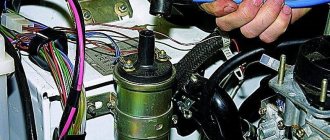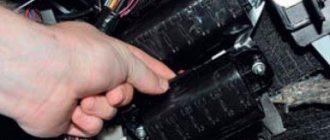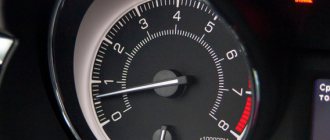Electrical problems
If you notice that your VAZ 2114 is difficult to start, then first of all you should check the main electrical components and assemblies that affect its operation.
These include:
- starter;
- spark plug;
- throttle;
- electronic control unit.
In this case, the check should begin with the candles.
If the battery is in perfect order, then you should carefully examine the spark plugs. The presence of oil, carbon deposits, or colored spots on them may indicate that they are faulty. In this case, there are two options for solving the problem - either clean the existing spark plugs (for example, calcinate them or clean them with fine sandpaper and solvent) or replace them with new ones. The last option is the most preferable, since only it will help you find out for sure whether the spark plugs are to blame for the malfunction or not.
If upon inspection it turns out that everything is in order with the spark plugs, then you should check the high-voltage coil. This can be made easier by replacing it with a new, similar one. If the ignition coil (or rather the block) is working properly, then you should proceed to diagnosing the starter.
Checking the starter consists of carefully inspecting it and monitoring the condition of the main elements - the degree of wear of graphite brushes, brass bushings, etc. In addition, you should check the starter using a multimeter (tester), “ringing” it between one of the brushes and the armature. If the tester shows an open circuit, then there is a break in the winding and the part will have to be replaced.
Another reason why the VAZ 2114 does not start well with a cold injector may be a malfunction of the electronic control unit. Checking it at home is extremely problematic, since you will need special diagnostic equipment.
That is why you should either contact a service center to check the ECU or try replacing the unit with another one and try to start the car again. If the car starts right away, then the problem was in the block. In this case, you will have to either buy a new ECU or reflash the existing one (for this you will also need to contact a car service).
Starting a VAZ 2115 in cold weather: why does the car start poorly and how to fix it?
It happens that you urgently need to go to work, but the car, after sitting all night, will not start.
So why does a vehicle that is in good working order after the last trip suddenly refuse to start? Or does it stall as soon as you crank the engine? Let's look at the reasons why a car may have difficulty starting when cold. First of all, it is necessary to make a reservation - your car starts perfectly if the engine has not had time to cool down, but in the case when the vehicle sits until the engine has completely cooled down, starting is difficult or completely impossible. In such a situation, even modern systems for heating and maintaining engine temperature do not always help. Let us consider in more detail the situation when a cold engine does not start well.
On diesel
Some of the reasons for power loss listed above are also relevant for diesel engines. But there are also a number of specific points associated with diesel engines that should be mentioned. One of the most common causes of power loss in a diesel engine is the failure of the turbocharger. When this unit fails, it usually begins to emit a characteristic whistle, which is difficult to confuse with something else. But in order to accurately determine the breakdown, you will have to send the car to a car service center. There they will scan it and identify the problem. Why might the turbo turn off? Here are some options.
- The charge air pressure sensor has failed.
- The turbine has simply exhausted its factory life.
- The tightness of the joint between the compressor and the motor is broken.
- The air path is clogged.
- The turbocharger axis has become coked, causing its rotation to slow down.
- The turbocharger shut-off valve has failed.
A characteristic external sign of a compressor failure is blue smoke coming out of the exhaust pipe.
It occurs due to the combustion of oil, the excess of which enters the combustion chambers of the cylinders due to leaks in the compressor. If the tightness of the compressor discharge line is broken, air leaks occur and the mixture becomes too rich. When it burns, not blue smoke comes out of the chimney, but black smoke. Finally, white smoke indicates that the oil line through which oil is drained from the compressor is clogged.
VAZ-2115 why the car does not start in cold weather
Back to the club VAZ / Lada 2115
Hello! Please help me with practical advice. I would like to know why the VAZ-2115 car does not start in winter. Of course, I already checked the obvious points like a dead battery.
Yangosyarov Semyon Filimonovich
Greetings. Actually, the issue may not always be related to the battery. It is possible that there are problems in the oil supply system. In winter, the car often does not start due to low coolant levels.
By the way, in cold weather you should also take care of changing summer oil to winter oil, which is more resistant to low temperatures. In addition to liquids, there may be a bunch of other problems with electronics. For example, the wires are damaged or the contacts have come loose somewhere.
Prevents motor activation from carbon deposits on the same contacts. Another problem is burnt fuses and spark plugs, which can become flooded with fuel. Try checking everything I listed above and start the car again.
If all this does not help, then there is a possibility that some sensor has failed. Such a problem can only be identified in a car service center.
Thank you for the smart advice. As it turned out, my candles were flooded. Tell me, is it possible to somehow restore them? Or do I have to buy new ones?
The VAZ-2115 may not start due to oil thickening. This is detectable with the naked eye. Oil intended for the summer period, with poor technical characteristics and heavily contaminated, thickens especially quickly. If you can’t change the oil, then you will have to wait for the weather to warm up or make forced emergency trips.
Naumenko Mikhey Onufrievich
In extreme cold the battery may be discharged. Therefore, in cold weather, it must be charged for at least six hours before planning a trip. If after charging it still does not perform its functions, then you need to purchase a new one. If your battery has ceramic plates, you can expect them to fail if the device is completely discharged several times.
In cold weather, the ignition system can also fail. Therefore, first of all, you need to replace the old candles with new ones. A good alternative is the process of calcining old candles. This is done as follows.
Candles are installed on a stand made of durable metal, which in turn is placed above the gas stove. Candles warm up for no more than 40 minutes. As a result, the coating on them will come off, and the insulators will turn white.
But if the candles turn red, then you need to eliminate it by soaking it in a so-called rust converter for two days.
I have contact
As electricians say, there can only be two faults: there is no contact where needed, or there is contact where it is not needed. This rule also applies in the situation under consideration. The arrow will jump if the joints are oxidized or weakened. Moreover, most often this happens when additional consumers are connected: low beam, headlights, etc.
As mentioned above, the first thing to do when diagnosing DTOZH is to check the contact in the connector. Returning to the previous section, the following should be added: if the sensor malfunctions, the readings fluctuate within the same range, and if they change chaotically, the wiring may be damaged. How important the negative contact is - the mass - will be confirmed by one case described by a forum participant.
The gauge needle sometimes jumped to 130°C. After stopping the engine, it showed the correct result - 90°. The voltage at the battery terminals when the engine was not running was about 12.5 V, and after starting it rose to 13.7.
After a year and a half of unsuccessfully searching for the cause, replacing the battery, alternator and two temperature sensors, I came across one grandpa who installed an additional ground wire from the engine to the body, and the problem was solved.
Impact of sensors
Most VAZ-2115 cars operate on the “January 5.1” controller. Crankshaft, temperature and throttle sensors are involved in starting the engine.
The VAZ 2115 does not start well in hot conditions.
DPKV malfunctions usually appear regardless of temperature, but it is worth checking its resistance and comparing it with the data in the calibration table.
A more common malfunction is DT . Remove from position and place in a container with a cooler. We measure the resistance with a multimeter: it should be in the region of 1350 - 1880 Ohms. If you have a thermometer, you can check it using the table. If not, it doesn’t matter either, just heat it to an arbitrary temperature. As T increases, the resistance decreases. On a fully warmed up engine it is 87 - 109 Ohms. If the ohms do not change or drop to 0, change the DT.
Attention - air
Finally, another possible reason for sudden movements of the needle is the presence of air bubbles in the antifreeze (“airing” of the system). Since the air and antifreeze have different temperatures, the needle jerks. An indirect sign of this malfunction is the splashing of coolant from the radiator cap or expansion tank, as well as a decrease in the filling volume.
PS In order not to upset Logan drivers, on the Duster and the second generation Logan-Sandero the temperature indicator on the dashboard was completely removed. As they say: no pointer, no problem.
Fuel system problems
Among the elements of the fuel accounting system, the following factors influence engine starting:
- presence of gasoline in the tank;
- the integrity of the fuel lines under the “belly” of the car;
- cleanliness of the filters: coarse cleaning (located in the tank) and fine cleaning (located under the car, to the right of the spare wheel compartment).
The carburetor starts poorly on a hot VAZ 2107.
Also included in this category are electrical components that are directly related to the fuel supply. This is an electric fuel pump and a fuel pump relay.
While checking other methods, you need to be completely sure that the VAZ 2114 with an injector is filled. “Yes, there are still five liters there” according to the indicator on the tidy; otherwise, “I filled it up yesterday, I couldn’t spend that much” are not suitable. The gauge may lie, and there may be leaks in the tank or fuel lines. Carefully check the car for fuel leaks; just in case, fill in 5-7 liters of gasoline from a canister.
See:
The mesh in the tank rarely gets clogged, leave this option for last, but it’s worth trying to change the fine filter if electrical problems are ruled out.
The operation of the fuel pump is checked by ear (after turning the key, it is desirable to hear its operation, if not, the pump has “died”, according to another pump relay, as it is also called a broken wiring). According to the manual, you need to connect a pressure gauge to the fuel system. If the pressure does not hold at 2-2.5 atm, the VAZ 2114 does not catch due to insufficient fuel pressure.
Causes of problematic startup
Causes of problematic starting of a cold engine
When determining the reasons why the car has trouble starting when cold, you will first need to make sure that the battery is not discharged and that the starter is in good working order (the engine turns smoothly and smoothly).
A separate reason that requires exclusion is refueling a car with low-grade gasoline. The quality of the fuel being poured greatly influences the trouble-free starting of the vehicle.
If the battery is not discharged, the starter is working properly and the fuel is of appropriate quality, you can suspect the following main problems if it is difficult to start the vehicle when it is cold:
Having considered possible malfunctions due to which the car may not start well when cold, let’s move on to studying ways to detect and eliminate them.
Troubleshooting and troubleshooting in different types of engines
A problem with spark plugs is a common cause of poor starting in a cold engine.
Different types of engines have their own trouble indicators. It happens that a gasoline engine has difficulty starting when cold, and one of the main ways to find out the cause of the problem is the spark plug.
It may also be the reason why diesel engines have difficulty starting in cold weather.
Indications for checking spark plugs, testing the battery, checking explosive wires and the ignition coil are jumping speed, engine tripping and poor cold starting, but only when the problems go away after warming up.
If the spark plug is dry, the problem is in the fuel line, as it indicates that fuel is not being supplied to the system.
Let's examine the spark plugs. Having unscrewed the spark plug, we carefully examine it. If the spark plug is wet, this indicates an overflow of fuel. Then suspicions fall on an electrical failure. We check the high-voltage wires, then we diagnose the ignition coil and battery.
We check the performance of the spark plug itself: serviceable spark plugs have a good spark. If the spark plugs fail, it is better to replace them with new ones. High-voltage wires can be checked in a dark room - if a glow is visible in the dark, the wires have been broken and they also need to be replaced.
Diagnosis of the causes of difficult starting
When a car has difficulty starting from a cold engine to a cold one, there may be different reasons. If the indicator is a dry spark plug, this is a sign of a problem with fuel supply. This can happen due to clogged filters - fine and coarse cleaning. If the engine still has difficulty starting when cold, pay attention to the injectors.
A faulty injector may be indicated by a spark plug flooded with gasoline after an unsuccessful start.
Another characteristic feature of this malfunction is poor starting in hot weather with a warm engine, and in winter problems arise with starting a vehicle that has already cooled down.
You can check whether the problem is correctly detected by reducing the pressure in the fuel system before stopping the engine for an extended period of time. The injectors may be incorrectly adjusted or leaking.
Additionally, we examine the fuel system for leaks, kinks or creases. Due to damage, air can leak inside and prevent the engine from starting when cold.
It happens that the starter is fine, the spark plugs and wires are normal, but the engine does not start. Then you need to look for the cause in the sensor that regulates the coolant or check the pressure in the fuel system.
Carburetor
The main reasons for poor starting of a carburetor engine after cooling to a cold state is the failure of the ignition distributor. Determined by cranking the starter - it turns out that the engine does not “grab.”
VAZ 2110 does not start when hot cause of breakdown
2110 does not start when hot
, one of the reasons for the breakdown, here is the video!! For the development of the channel.
Starter. Often the cause is a jammed “retractor”. If you are standing in a field, you should try hitting it with something heavy like a large key (without fanaticism) - it helps. If the car is parked in a garage, you should remove the starter and try to start it directly from the battery.
For this purpose, press the housing to the zero terminal of the battery, install the wire with the alligator clip on the positive terminal of the battery and bring it to the positive of the retractor. If the starter makes an attempt to jump out of his hands, what can our client do normally (be careful, this procedure is not recommended without basic safety knowledge and an assistant!).
Leaking cylinder head gasket
This problem is one of the rarest causes of engine overheating in VAZ 2114 cars. When it occurs, overheating is a secondary symptom that may be accompanied by a number of others:
- oil leaks from under the cylinder head;
- uneven engine operation and low compression;
- increased oil consumption, noisy engine operation and gas flow, black exhaust.
In this situation, at best, the solution would be to replace the cylinder head gasket. At worst, a major overhaul of the engine with cleaning of all internal cooling channels.
When the engine gets hot, it is dangerous not in itself, but because of its consequences. Long-term driving at elevated operating temperatures first leads to loss of properties of elastic parts: valve stem seals and piston rings. Because of this, oil consumption increases, and engine operation becomes uneven and dirty. All this leads to expensive major repairs.
The consequences of severe overheating are even more severe: the cylinder head and cylinder block are deformed and sometimes crack. An engine that has survived this can no longer be repaired.
Help Friends! car VAZ-2114 1.6 8kl, the problem is that the engine heats up, the fan reaches the red mark and turns on, I wouldn’t pay attention, but it even heats up on the highway if the speed is up to 100 km/h then the temperature stays slightly above 90, and if more than 100 km/h, then the temperature also rises) changing the thermostat did not help). Why does the engine on a VAZ 2114 8-valve injector get hot?
Possible consequences of long starter operation
When the starter is turned for a long time, the greatest damage is caused to the battery and starter. The first one loses its charge very quickly. When starting the engine, the starter consumes a lot of current, so the battery consumes most of its charge, which is then (after the engine has been started) replenished by charging from the generator.
Bendix failure
Old and new Bendix
With each such idle start, voltage from the battery is supplied to the bendix, which begins to rotate the shaft until the engine starts. At this moment, the splines on the bendix are severely worn out, and the bearing may also crumble or hum.
In these cases, there is only one way out - replacing the starter with a new one.
VAZ 2114 takes a long time to start when cold. The car takes a long time to start when cold and when stopped
Why is the VAZ 2114 8-valve injector difficult to start?
For some reason, it seems that many drivers of this model will be interested in the question of why the VAZ 2114 8-valve injector does not start well. Finding the cause of this phenomenon is not as easy as it might seem at first. This is due to certain difficulties in troubleshooting in this model, since injection systems differ from carburetor systems. The algorithm for identifying possible problems will be built differently, adapting to the design features of the machine.
Why is the VAZ 2114 8-valve injector difficult to start?
, we will try to consider in this work. In a short article it is impossible to consider absolutely all possible problems; there are some that can only be identified with the help of diagnostic equipment. But, nevertheless, we will try to analyze as many such situations as possible in order to help all VAZ 2114 owners decide what to do in such a situation.
Why might the engine be difficult to start?
You can look for the culprit in such a situation in several directions. Among them, the most important problems are:
- Malfunctions in the ignition of a VAZ 2114 car
- There is no pressure in the fuel rail of the 8-cl VAZ engine
- Air leak into the VAZ intake manifold
- Timing belt marks are misaligned
Engine diagnostics using spark plugs
Let's look at the first option, why the VAZ 2114 doesn't start well. To do this, unscrew the candles and look at their color. If there is black dry carbon on the candles, we can say that the engine has been running for a long time on a rich mixture, which covers the candles with black carbon.
Why does black carbon appear on the spark plugs of an injection car:
- Malfunction of the mass air flow sensor
- The first oxygen sensor has failed
- Fuel pressure regulator is faulty
- Malfunction of fuel injectors
White carbon deposits on the spark plugs of an injection car appear due to a lean mixture, the reasons for the appearance:
- Everything is the same as with black soot
- Malfunction of the fuel pump or clogged fuel filter (check the mesh and fine filter)
- Air leaks through the air flow sensor pipe, the place where the regulator is attached to the XX joints of the manifold.
Checking the spark plug spark
The lack of a spark on one 8-cl spark plug of a VAZ engine will not affect the engine starting, it will be noticeable when idling, tripping and jumping revs. But if the ignition module of the VAZ 2114 is faulty, then the spark disappears in two cylinders 1-4 or 2-3. To check the spark plug spark, take out the fuel pump fuse, unscrew one spark plug or take a spare one, remove the high-voltage wires one by one, put them on the spark plug, then put the whole thing on ground (in this case, the valve cover) and ask a friend to crank the engine with the starter, so we check each spark plug. If there is no spark on one spark plug, most likely there is a defect in the explosive wires; if there is a spark in two or all spark plugs, it is highly likely that the problem is in the ignition module or the wiring to it.
The timing marks on the VAZ are not set correctly
Another reason why the VAZ 2114 does not start may be a mismatch of the timing marks. The reason for the mismatch of the marks may be weak timing belt tension, cut teeth, or the crooked hands of a mechanic at a service station.
A discrepancy of more than two teeth will noticeably affect the operation of the engine of the fourteenth. With a slight deviation, the engine starts up a little worse, does not hold idle, and stalls when switching to neutral gear. If the deviation exceeds 4-5 teeth, the sound of the engine changes, air escaping under pressure through the valves that are not opened in time becomes audible, thrust noticeably disappears, and starting the engine is extremely problematic.
- To check, we need a “10” key; use it to unscrew the three bolts securing the timing case.
- Next, put the car in 5th gear and push it until the mark on the camshaft pulley and the rear cover match, you can also turn the pulley with the key to “17”
- We remove the protective plug from the clutch housing and see if the mark on the flywheel matches the mark; if not, then you need to loosen the tension roller and align the belt according to the marks.
Checking the crankshaft sensor VAZ 2114
Perhaps this is the only sensor without which a VAZ car will not be able to start at all. If, when the engine is cranked with the starter and the ignition and fuel supply are working properly, there is no seizure or ignition of the fuel, then the problem is in the DPKV. The cost of the sensor does not exceed 300 rubles; it is better to replace it. However, there is a way to check: checking the crankshaft sensor video
If after the performed operations it was not possible to determine the breakdown, please write your problem in the comments, I will be happy to answer your question!
Fuel supply: fuel pump failure and other reasons
If all of the above problems are absent, then you should check the performance of the fuel system. Often the reason lies in the following:
- the fuel pump has failed;
- low pressure level in the fuel line;
- the filter is clogged;
- the injectors are out of order;
- low pressure in the ramp.
You need to remember: it is quite difficult to check the performance of the fuel pump on cars with an injection engine. You can determine its performance by its sound - immediately after turning on the ignition, it should definitely make noise. If the fuel pump is faulty, it will need to be replaced. Such devices do not require repair.
You should check the pressure level in the fuel line and rail. To do this you will need to use a special pressure gauge. The normal pressure level for VAZ 2115 and VAZ 2114 is from 2 to 2.5 atm.
If this indicator is lower than specified, then the car will have poor grip and stall while driving. In this case, it will be difficult to fix the problem yourself. It is worth contacting a car service. It often leaks at the ramp connection point.
When a car has a high mileage and uses relatively low quality fuel, the problem often lies in a clogged filter. It needs to be replaced. The cost of a filter is usually no more than 250-300 rubles. Often the problem is also due to poor quality fuel in the injectors - they are simply clogged. Moreover, in some regions, even branded gas stations sell relatively low quality fuel.
Cleaning them requires special equipment. But often the injectors do not cope with their function due to lack of power. Checking its presence or absence is relatively simple - just disconnect the special connector and use a tester.
As in the case of measuring the voltage on the battery, you need to set the measurement limit to 20 V. The voltage should be 12 V. Lack of power indicates the need to check the wiring for an open circuit.
In some cases, the problem lies in armored wires and candlesticks. It is enough to replace the power cables that supply voltage from the coil to the spark plug - and the motor begins to operate smoothly and unpretentiously.
The VAZ 2115 engine stalled: causes and repairs
There are quite a lot of reasons that can cause the VAZ 2115 engine to stop. If we assume that there is gasoline in the tank, the fuel pump and starter are working normally, then first of all you need to check the integrity of the timing belt. If it is torn, it must be replaced.
The reason that the engine does not start may be a faulty crankshaft position sensor (CPS). DPKV is the only sensor in the car, due to its breakdown, the engine cannot start. Its signals, arriving at the controller of the engine control unit, allow the latter to synchronize its operation with the operation of the gas distribution mechanism. This generates signals that control fuel injection and the ignition system. Thus, the operation of fuel injectors and ignition in the fuel mixture supply system is synchronized.
Checking the DPKV begins with checking the integrity of the electrical wiring. If the wires are damaged, they are replaced.
The sensor itself is located next to the generator drive pulley. It is removed and a visual inspection is carried out. If the housing is damaged, the sensor must be replaced.
In cars of recent years of production, the “check engine” indicator located on the instrument panel will indicate the need to check the sensor. On older cars, you can check the DPKV using a multimeter. The resistance of the sensor measured with its help should be in the range of 600...900 Ohms. If the DPKV is working, then it is recommended to carry out further troubleshooting at a service station that has a special diagnostic scanner.
Diagnostics
So, to determine the specific reason for the long start-up of an injection-injected internal combustion engine, you should start with a high-quality diagnosis. Usually, they check the compression in the cylinders. Its values must be within 12 atm for this to be considered normal. In this case, there should be no deviations between these indicators in each of the cylinders (maximum - 1 atm).
Then the spark plugs must be replaced. This will have an effect on the engine and it will now start much faster. However, if everything is not in order with the motor, then the normal starting time will last only 1-2 days.
Therefore, high-voltage wires should also be diagnosed. Diagnostics will make it possible to find out whether the cables have a breakdown, which is clearly visible by the spark coming out at night. This is done as follows: the car starts in the dark, at the same time you need to monitor which wire sparks.
The ignition coil also needs to be checked. Many experienced drivers do this: they install a known good and new module instead of the original one, then check the engine starting for several days. If everything is normal, the start-up does not take long - it means that the whole problem was in the bobbin (ignition coil).
If there are no changes, the test continues. This time you should test all filters, including the air filter. Next is checking and replacing all sensors and regulators. Pay special attention to the mass air flow sensor.
The next stage: testing various connections, checking the wiring for good contact, cleaning the masses and flushing the throttle assembly.
If nothing changes again, then it is recommended to check the engine fan relay. It often causes similar problems with starting on a fuel-injected internal combustion engine. You can test the relay if you remove the wire from the temperature controller installed on the thermostat.
The fan should turn on after these steps. However, after measuring the resistance value on a warm internal combustion engine, the system can produce low temperature data, although the temperature inside the engine is clearly more than 90 degrees. Why is there such a difference? It turns out that this may well be a buggy DTOZH, which for some reason was not checked earlier. It must show the real coolant temperature, otherwise chaos will begin in the system, and it is not surprising that the engine takes so long to start.
Causes of overheating, troubleshooting
Why does the VAZ engine get hot? The main reasons are:
- radiator clogged externally or internally;
- a broken or inoperative fan;
- faulty thermostat;
- burnt cylinder head gasket;
- insufficient amount of coolant;
- water pump.
If the engine overheats only when running, it means that an exhaust gas leak has been detected. However, when the engine continues to heat up after stopping, then there is definitely one of the problems listed above. The engine will heat up if you give high speeds, but drive slowly.
Sometimes it is impossible to see and diagnose the presence of air or gases in the system. Then you need to put a bag on the neck of the expansion tank, start the engine, collect the vapors in the bag, and then smell them. If there is a smell of antifreeze, then you need to look at the pump, radiator or thermostat. If the vapors have a gasoline “aroma,” then the cylinder head gasket may be broken.
Removing contaminants
In summer, various pollutants can significantly clog the radiator grille. Naturally, air cooling processes will not be as efficient. As the coolant cools in the radiator, this process also worsens. Preventive action is cleaning the radiator. Paint that peels off honeycombs also causes this effect.
You can rinse the radiator thoroughly at a car wash. The jet from the Karcher sink should not be brought near the radiator honeycombs. Water or other water-based solutions will form scale. When such compounds are oxidized, various impurities appear. Sand and dirt can easily cause the radiator to clog from the inside. What to do? Flush the entire cooling system completely. As a result, we will see cloudy and dirty coolant.
Problems with fan, thermostat, radiator cap
Often problems with the fan can occur if the temperature sensor has failed. The fan motor itself is almost always in working condition. Possible blade damage. Fan failure may be due to a clogged radiator. The bottom of the radiator becomes covered with sediment and dirt.
The temperature sensor is in most cases located at the bottom. The sensor does not warm up well, and as a result the fan does not work (or works, but too late). If there is dirt present, then washing is needed. The temperature sensor wire should be short-circuited. The service fan will start. Sometimes thermostats stick closed as a result of oxidative processes.
As a result, the coolant simply does not flow into the large circuit. Sometimes this can lead to serious problems. But such cases are quite rare. Signs of thermostat malfunctions appear when, when the engine is warm, the heater blows hot and the inlet valve is cold. This means the closed thermostat is stuck. Thermostats need to be replaced occasionally.
If the radiator cap has expired, this may lead to the coolant boiling. This entails low pressure in the system. If the engine operates at normal temperatures when moving, but instantly boils when stopped, then this indicates a faulty cover.
If engines get hot at idle, you need to pay attention to this too.
Starter failure
If all other system components are in order, then the reason for the inability to start may lie in the absence of a starter. Typical problems:
- poor contact at the terminals;
- the starter shaft bearing has failed;
- The solenoid relay has stopped working.
It should be noted: the location of the power terminals on the starter suggests the presence of moisture. Therefore, often the contact simply oxidizes, which leads to problems in the operation of the device. That is why you need to carefully examine the contacts. Then clean them and check the voltage. If it is missing, there may be a break in the wiring.
When there is voltage, but the starter does not turn, it is often a problem with the bearings. To replace it, you will need a clean garage, as well as a special puller. This is the only way to dismantle it.
A little more often than a bearing, the solenoid relay fails. Sometimes it just jams - just tap it lightly with the key.
It is very simple to check the functionality of the retractor - just place the starter on the engine block and then touch the contact of the wiring relay connected to the positive terminal. If the starter starts spinning, it means the solenoid relay is in working condition. All of the problems listed above are typical and do not require any major repairs.
Separator design
The VAZ 2114 gasoline vapor separator is a small, completely sealed tank made of metal or impact-resistant plastic. It is installed in the right rear part of the car on a special bracket. Using a hose system, it is connected to the gas tank (from where vapors flow through drain pipes) and to a two-way valve. The total volume of this device is 7 liters.
Location of the separator VAZ 2114Once in this tank, the vapors accumulate in it and, due to increased concentration and cooling, condense. Drops of condensation settle on the walls and bottom, after which they gradually flow back into the gas tank. The same vapors that did not have time to condense flow towards the two-way valve. From its name it is easy to guess that it works in both directions at once - “for the intake” of atmospheric air into the tank and “for the release” of fuel vapors outside.
Despite the obvious simplicity of the fuel ventilation system and the minimum of parts located in it, it still breaks down, leading to rather unpleasant consequences.
So, signs of a vapor separator failure may include:
- smell of fuel inside the cabin;
- the smell of fuel near the car (and a lot of time has passed since refueling);
- gasoline stains near the neck of the tank;
- drops of fuel on the ground after a long stay.
Having noticed these signs, we can conclude that the VAZ 2114 gas tank separator is cracked or leaky and is no longer doing its job.
Coil
Modern cars are no longer equipped with distributors. There is an ignition module here. VAZ-2115 (16 valves) is no exception. Sometimes breakdowns happen. Because of this, the VAZ-2115 does not start. The reasons are a faulty ignition distributor.
This item cannot be repaired. And in order not to waste time on diagnostics (or if you don’t have a multimeter), it’s worth installing a known-good ignition module. The VAZ-2115 should start without difficulty. Sometimes the high-voltage wires themselves pierce. But in this case the car starts and starts. This can be heard by the characteristic sound of the engine.
Malfunctions of the car ignition system and other breakdowns
It would take a very long time to list the possible reasons why a practically new car, not to mention used VAZ models. In this case, the solution to the problems that arise is both independent repair within some 10-15 minutes (if you have the appropriate knowledge, experience and spare parts), and rather labor-intensive work. We are not able to provide advice on how to correct each of the cases we have named due to the limited space of our article. But we will still allow ourselves one – a common one.
Winter never comes unexpectedly (we don't mean utility services, for them winter is always news). Thus, in anticipation of the oncoming cold weather, carry out a preventive inspection and, if necessary, repair of your personal vehicle. Replace questionable parts (filters), change the oil, check the injector, and so on.
And then the question of why the VAZ-2115 (or any other make and model) starts poorly or does not start at all, even in mild frost, will be irrelevant for you.
DTOZh replacement procedure and timing
The procedure for replacing the DTOZh may differ depending on the car model. At the VAZ, to carry out the process, you need to prepare several tools, including the obligatory set of wrenches.
According to the classic scenario, the coolant will have to be drained, otherwise replacing the DTOZH cannot be called correct. Although there are several replacement options that do not involve draining.
As mentioned above, one of the DTOZH is located in the thermostat. It screws in from the side. The second is located a little lower, wrapped in the cylinder head.
A little about the timing of replacement of DTOZH. If we are talking about a regulator that goes to the pointer, then it must be replaced at the very moment when the temperature values go astray. This is easy to check: for example, when the engine is cold, the coolant needle tends to the red zone or simply wanders. This is an error and requires correction, i.e., replacement of the sensor.
In some cases, it also happens that it is not the regulator itself that is to blame, but the wiring or contact. You need to check everything, and only then decide whether to change it or not. Testing the wiring is also easy: the wires are disconnected from the DTOZH, the ignition is turned on and a short to ground is made. If the arrow jumps up, then everything is in order with the wiring.
The second DTOZH changes if the machine itself is not working properly. For example, the speed of a cold engine does not increase, but when it is hot it reaches a value of 1500 rpm. Fault number 2 can also be judged by the cooling fan, which turns on too early or does not do so at all.
Temperature controllers that have been removed are easiest to check. They must be immersed in boiled water heated to certain values, then connect an ohmmeter to measure the resistance coming from the DTOZH.
- Absolutely legal (Article 12.2);
- Hides from photo and video recording;
- Suitable for all cars;
- Works through the cigarette lighter connector;
- Does not cause interference to radios and cell phones.
What sensors can influence this?
Most VAZ-2115 cars operate on the “January 5.1” controller. Crankshaft, temperature and throttle sensors are involved in starting the engine.
ECU January 5.1
DPKV malfunctions usually appear regardless of temperature, but it is worth checking its resistance and comparing it with the data in the calibration table.
A more common malfunction is DT. Remove from position and place in a container with a cooler. We measure the resistance with a multimeter: it should be in the region of 1350 - 1880 Ohms. If you have a thermometer, you can check it using the table. If not, it doesn’t matter either, just heat it to an arbitrary temperature. As T increases, the resistance decreases. On a fully warmed up engine it is 87 - 109 Ohms. If the ohms do not change or drop to 0, change the DT.
The throttle assembly is completely disassembled and cleaned. One of the problems is dirt, which expands when heated and interferes with the normal operation of the injection. If the TPS malfunctions, the car not only does not start when hot, but also “does not drive” (sometimes stalls and does not start) after warming up.
The TPS is checked with an ohmmeter with the engine running. Place the multimeter on the input and output contacts, ask an assistant to press the gas. The readings should change and return to their original values at XX. If the resistance does not change when you press the pedal or the device shows infinity, the sensor needs to be replaced. At the same time we check the IAC. It usually causes the car to be unstable at idle or stall but start.
A malfunction of the mass air flow sensor on cars with January 5.1 is recognized by the fact that the car starts when hot and immediately stalls. The sensor comes into operation only after startup. But on a car with January 7.2, the mass air flow sensor is involved in the start - without it the car will not start.
Problems with the fuel supply system
Very often the VAZ 2114 8-valve injector does not start well in cold weather due to a malfunction of the fuel system. To check it and identify possible malfunctions, you will have to carry out diagnostics:
- Electric pump.
- Fuel filter.
- Fuel line.
Troubleshooting should begin by inspecting the fuel pump. Checking it is quite simple - when turned on, it should buzz, which will indicate its operation. If no sound is heard, then the pump is faulty and will have to be replaced with a new one of a similar model.
The next common cause is clogging or destruction of the filter. Everything here is also simple - you just need to remove and inspect the filter and, if it is worn out, replace it with a new one.
If the filter, like the fuel pump, turns out to be working, you will have to measure the pressure inside the fuel line (for this, there are both special devices and entire testers that allow you to diagnose the entire fuel system. The simplest version of such a device costs just over 1,000 rubles). If the pressure in the line turns out to be normal, then you should think about other possible reasons.
Injector
There is no point and no need to talk about the design of the injector. You can take our word for it, it's pretty simple. So you can figure it out on your own. And if this problem is beyond your capabilities, then it is better to leave it aside and immediately move on to the causes of problems in the fuel system, due to which the VAZ-2115 (like any other model with an injector) has difficulty starting in cold weather.
The first and, unfortunately, all too common reason is the low quality of gasoline offered at gas stations. A characteristic feature of this fuel is its high water content.
Second. You have neglected the operational care of individual components and parts of the car, as a result of which the injectors and coarse and fine fuel filters are littered.
Third. There is no pressure in the fuel supply line of the vehicle. The reason for this may be:
Fourth. At this point we will combine several reasons for not prolonging the story:
As we can see, many of the mentioned reasons for the failure of a car engine to start, related to the operation of the fuel system, are quite simple and can be easily corrected with your own hands right on the spot.
Another question: how will you do this in the cold?


